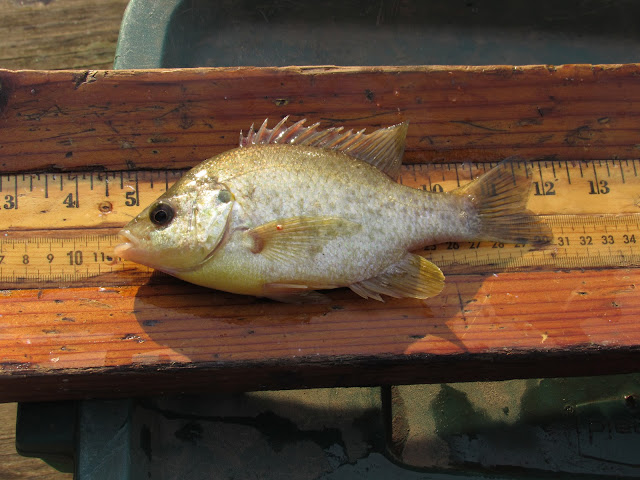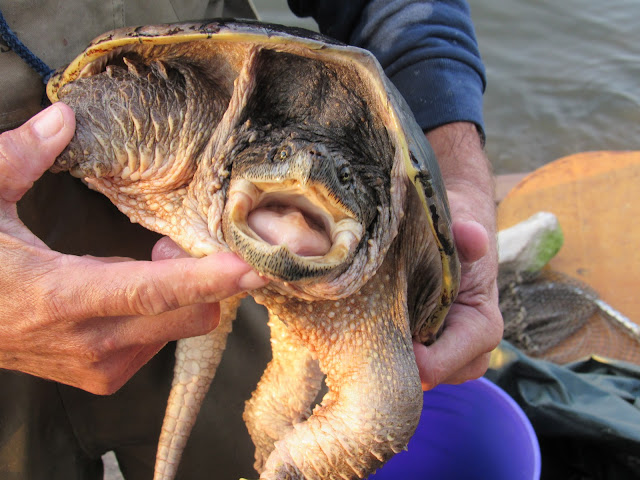Bridgeview Park
Thursday, October 27, 3:45 PM to 4:00 PM
Temperature: 60-ish degrees Fahrenheit
Weather: Sunny to partly cloudy
Before getting into the actual trip itself, I'm going to go off-journal for a bit. Earlier in the day, I'd been at Marina Point, when I spotted my favorite bird (above and below):
This is the fall-plumaged Common Loon (Gavia immer), my favorite bird. As I've explained before, I appreciate this bird for three reasons: It spends lots of time in the wilderness, it's quite awkward on land, and it enjoys making weird noises at night. All three of these habits of the loon I consider applicable to me personally, especially the last one. According to Ebird, this was the first Common Loon seen on Lake Springfield this fall, though I doubt it actually was.
As usual in October, there were about one hundred American White Pelicans (Pelecanus erythrorhynchos) at the mouth of Sugar Creek. It somewhat saddens me that I'm getting to the point where I go, "Oh, it's just a pelican." Back when I first saw these, they gave me so much joy, and now I don't even look twice. I suppose this is the indifference of experience. The commonplace becomes the ignored all too soon. Thankfully, birds move on, and once the temperature goes down a bit, pelicans will become rare and I will start wanting to see them again.
Alright, time to electrocute some fish. On a field trip at Bridgeview Park, we met with two IDNR biologists who were studying the fish in Lake Springfield. They had already zapped up some fish. All of these fish are alive, by the way. Electroshocking, which is the correct name of this procedure, is using an electrical shock inputted into the water to stun fish, making them easier to catch, examine, and release. They are not harmed by this (so far as we know) and are promptly released back into the water immediately afterwards.
An exceptionally large Freshwater Drum (Aplodinotus grunniens) was the first fish of the day, captured some time before we arrived. Don't ask me why it's called a Drum, it just is.
This White Sucker (Catostomus commersonii) was a new fish for me. These fish aren't related to the "suckerfish" of aquaria (those are a type of catfish). Instead, they're more related to minnows.
Here's a far less welcome fish, itself a minnow, the Common Carp (Cyprinus carpio). Introduced from Europe, these bottom-feeding fish help to contribute to the muddiness of Lake Springfield's water by stirring up the silt on the lake bottom as they feed. This increases the pollution of the lake and makes it far less healthy. Hurrah. And they aren't half so bad as Asian Carp!
White Crappie (Pomoxis annularis) on top and Black Crappie (Pomoxis nigromaculatus) on bottom, showing the difference between the two fish. That's pronounced "Croppie" to you non-fishers.
Largemouth Bass (Micropterus salmoides) demonstrates its name quite well. The black marks on the tail are a natural, if unusual, coloring pattern. This fish generates thousands of dollars on Lake Springfield from fishermen seeking these fish.
White Bass (Morone chrysops), while native, are stocked in this lake for fisherman, as are many of the fish caught. For those not familiar with the term stocked, it means that the state fisheries bring in young White Bass in large numbers and release them for fishermen to catch.
White and Yellow Bass (Morone mississippiensis) (on bottom) show the size difference between these two. Once they had gotten this far through the fish, our two IDNR guides took us out on the boat. In front are poles with electrical emitters in the water. These, every so often, are charged, and the fish are shocked. If we were to touch them directly, it would kill us, most likely, but the fish are fine because the water takes the brunt of the shock. Our job is to then scoop the fish into nets:
We split into two groups in order to do this, and when it was my group's turn onshore, we measured and recorded some of the fish we'd caught.
First up was Illinois' state fish, and one of its most common, the Bluegill (Lepomis macrochirus). I've caught so many of these before that they kind of bore me. Let's move on.
Redear Sunfish (Lepomis microlophus) (the red "ear", actually a red dot on the gill cover, isn't visible here) are fairly common in Illinois, though I've never seen one before. Illinois fish are new for me.
This is a Green Sunfish (Lepomis cyanellus). Green Sunfish can survive nearly anything, so finding a large number of these is a sign of a polluted watershed. Thankfully, they are also present in small numbers in almost any body of water, and we found only a few. Still, Lake Springfield is fairly polluted. On a healthy large lake, there should be a mayfly "bloom", when large numbers of mayfly insects emerge at the same time for a few days, feeding all the wildlife around. This happens on Lake Carroll, where I usually go fishing. We don't have that here on Lake Springfield. Likely, this is the carp's fault, but there is enough speedboat traffic and other possible factors that could pollute the water enough for mayfly blooms to not happen.
We also had a Channel Catfish (Ictalurus punctatus). Catfish, for the unaware, are named for their whiskers. They have venemous fin barbels that, while not deadly, do hurt a lot if you grab the catfish wrong. The way it is being held above is correct. Some people think that the whiskers hurt, but they don't. Whiskers, on a catfish, are used to taste and smell their food. They roam about on the bottom of the lake, eating almost anything there. Channel Catfish grow quite large, and taste great (No fish were harmed, except for one Gizzard Shad eaten by the nearby gulls, in the making of this field trip.)
Yellow Bullhead (Ameiurus natalis) are a smaller catfish, but with similar habits and fin barbs to the Channel Catfish. They are much smaller, however, and commonly found in muddy farm ponds.
Here I am, measuring a Largemouth Bass. In order to see how well the fish are doing and growing, how well stocking went, and how many adult fish there are, IDNR weights, measures, and records as many of the fish as they can when electroshocking. They can't always do this with every fish...
Gizzard Shad (Dorosoma cepedianum) are Lake Springfield's most common fish, it seems. Everything eats them (we found shad in the mouths of a few bass we caught). These incredibly common fish eat plankton (microscopic life) found in the water. They are fairly slimy when handled.
I turned around at one pount, and found this Common Snapping Turtle (Chelydra serpentina) behind me! I did jump, a bit. Evidently, the IDNR biologists had brought a few turtles to show off. These are captive turtles, but there's nothing captive about a snapping turtle. They will try to bite you with that beak of theirs, but only if you get too close. You can get pretty close, as seen below:
It is said that birds are the closest relatives of dinosaurs, but this turtle does look the part better.
This half-blind Spiny Softshell Turtle (Apalone spinifera) was another captive turtle they had. This spines referred to are along the front edge of the carapace (top shell), just above the head. On a Smooth Softshell Turtle, these are absent. Both species of softshell turtles prefer large lakes and rivers, especially ones with sandbars or beaches (although, suprisingly, there is a Spiny Softshell Turtle in the Lincoln Land pond, which I see occasionally).
Here we have a Homo sapiens and a Red-eared Slider (Trachemys scripta elegans), the last two animals of the trip, excluding all the birds. There were quite a few common birds, but as this is a bonus journal, I no longer feel inclined to list every single bird and its specifics of when and where I saw it. There will be a couple more articles on the field trips I'll be going on, but those will be straight-up posts, not journal entries. I'm going to keep including Ebird checklists, as a certain subset of my readers will probably appreciate that.
Hope you all enjoyed what seems to be a Lake Springfield fish ID guide, albeit missing most of the species found here. I've been busy birding, and I've seen quite a few, including PEREGRINE FALCONS! so be watching for that. Goodnight (or morning, or afternoon, I'm just writing this at night. Honestly, you'd think after 111 posts and over a year of doing this, I'd know how to end a post. Nope! I still have no idea. A good conclusion in hand is worth three introductions in the bush.)
Ebird Checklist:
http://ebird.org/ebird/view/checklist/S32262124

























No comments:
Post a Comment